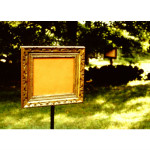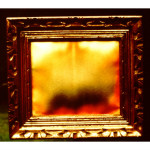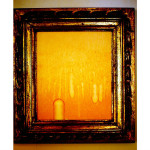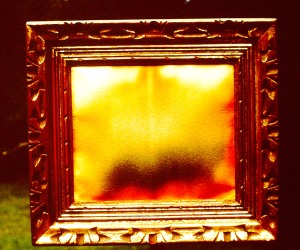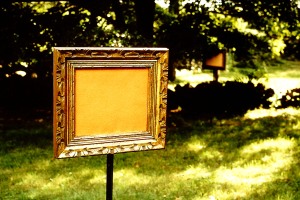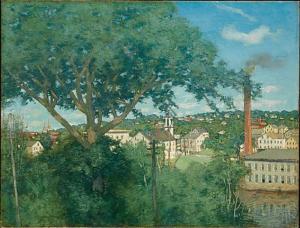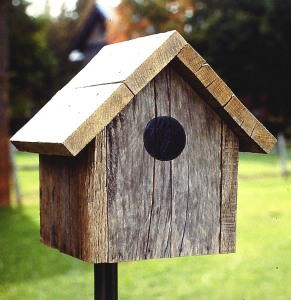- Landscape Paintings, acid/base indicator paper
- Landscape Paintings, acid/base indicator paper
- Landscape Paintings, acid/base indicator paper
- Landscape Paintings, acid/base indicator paper
Landscape Paintings was created for Weir Farm, CT, a National historic site that preserves the home and creative refuge of impressionist painter J. Alden Weir. In this installation, framed sheets of acid-base indicator paper were arranged around his property, exposed to the elements, and colored by the acidity of the rain.
(This piece was made possible in part from a Dieu Donne Workspace grant.)
“…In his current installation, Landscape Paintings, McQuillen asks us to rethink our romantic notions of the environment by having nature itself create ‘impressionist’ watercolor paintings on large sheets of acid-base indicator paper (similar to litmus paper). The irony is that the bright hues of the ‘paintings’ which are mounted outdoors in wooden frames, are caused by the acid rain, thus revealing man’s hand without lifting a brush. Even a place as idyllic as Weir Farm—or Brook Farm and Walden Pond, from where water was also gathered to create ‘paintings’ — comes out as less than pure by this ‘litmus test.’
What more can we look forward to from Charles McQuillen? Whatever happens, it is clear that this artist, who spends his days marketing textbooks for Houghton Mifflin in Boston, has changed how we see Weir Farm.”
– Angevin. Susan. “Sculptor Blends Art with Environmentalism,”
Weir Farm News.Wilton, CT. Fall, 1994.
Landscape Paintings grew out of an installation titled Watercolors (not shown). In Watercolors, I collected water samples from historic sites around the northeast United States, such as Brook Farm, Walden Pond, and Seneca Falls. These water samples were then individually frozen into egg shapes and suspended above large sheets of acid/base indicator paper mounted on boards with brass nameplates identifying the origin of the water. During the show the eggs melted creating a series of free flowing watercolor paintings. These watercolors were later mounted on the gallery wall.
Building on this idea, Landscape Paintings is a great example of how a site’s historical and social significance can enhance an installation with invaluable context. Weir Farm is a national historic site that preserves the home and creative refuge of impressionist painter J. Alden Weir. Painting at the turn of the 20th century, his landscape paintings celebrated pristine views of nature and also included images of the budding industrial revolution, including the factories and their giant smoke stacks that would come to symbolize a cause of acid rain.
Landscape Paintings draws on this tradition with a twist. Weir Farm was established as a historic site, in part to protect the open space from suburban sprawl. And the national park system has done an impressive job preserving the pastoral landscape. But, the national park service can only do so much to stop encroachment from the outside world. National monuments and sites are impacted by the acid rain created by factories hundreds of miles away. So, even though things may look pastoral and pristine in our own backward, we need take a more global and focused view of environmental issues.
In a way, Landscape Paintings is a lot like the Silent Suburb installation. From a distance, it initially engages the viewer on a whimsical level, but when you lean in to take a closer look, you intellectually smack your nose on a black circle painted where an entrance hole should be. I think that surprise can make the ideas behind the piece more engaging and memorable.
- Before reading anything, analyze the sequence of pictures of the installation and see if students can explain what happened from the evidence provided. (Image #1 show the piece upon installation. Image #2 shows the same frame after a rainstorm. Images #3 and #4 show the painting after they dried.) What is your initial response to what you see?
- Then, read the brief description. (If students are unfamiliar with acid rain or litmus paper you may need to do some additional scaffolding.) How does the description inform your interpretation of the piece?
- Read the review and Upon Further Reflection. Do these readings shape your understanding of the piece?
- Consider the works of John Sabraw, an artist who creates bright paintings from toxic mine runoff. You may also want to explore AMD&ART’s mine restoration efforts
Artists who collaborate with the environment to make art about the environment
Artists have long used natural pigments to create art. Contemporary artists are exploring new and different ways of using the earth’s natural properties to create art that instills a deeper understanding of the environment. Some of those artists are Ulrike Arnold, Andy Goldsworthy (video), Jacek Tylicki, and Alan Sonfist.

